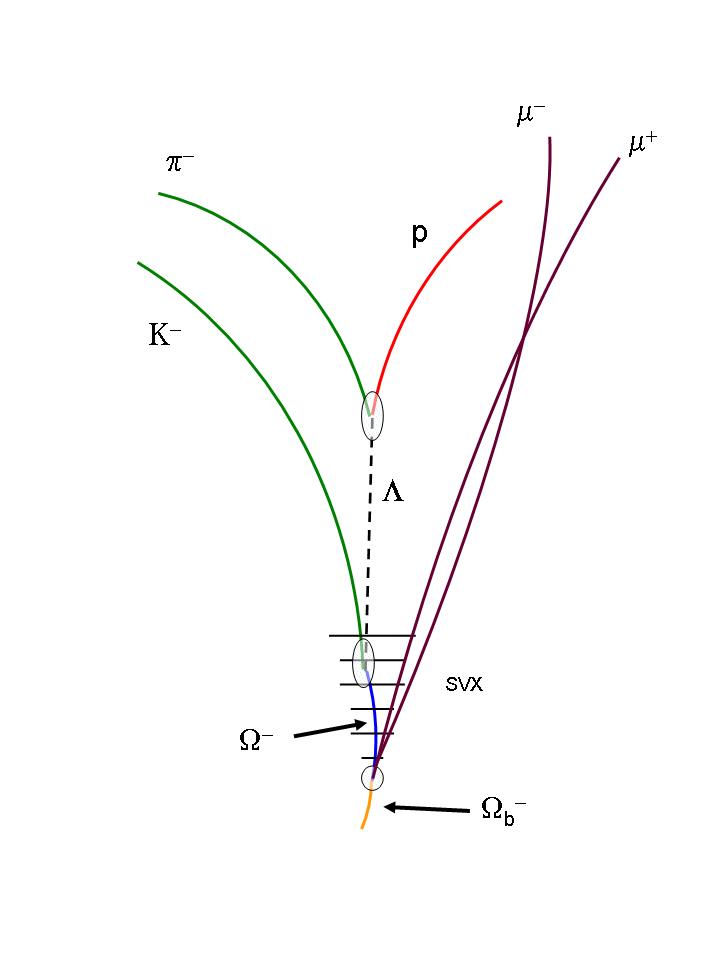This press release was issued by Fermilab today.

Once produced, the Omega-sub-b (Ωb) particle travels about a third of a millimeter before it disintegrates into two intermediate particles called J/Psi (J/ψ) and Omega-minus (Ω-). The J/Psi then promptly decays into a pair of muons. The Omega-minus baryon, on the other hand, can travel several centimeters and occasionally be measured in the CDF silicon vertex detector. The particle decays into an unstable particle called a Lambda (Λ) baryon along with a long-lived kaon particle (K). The Lambda baryon, which has no electric charge, also can travel several centimeters prior to decaying into a proton (p) and a pion (π). Credit: CDF collaboration.
At a recent physics seminar at the Department of Energy's Fermi National Accelerator Laboratory, Fermilab physicist Pat Lukens of the CDF experiment announced the observation of a new particle, the Omega-sub-b (Ωb). The particle contains three quarks, two strange quarks and a bottom quark (s-s-b). It is an exotic relative of the much more common proton and has about six times the proton's mass.
The discovery of this "doubly strange" particle, predicted by the Standard Model, is significant because it strengthens physicists' confidence in their understanding of how quarks form matter--and because it conflicts with a 2008 result announced by CDF's sister experiment, DZero.
The Omega-sub-b is the latest entry in the "periodic table of baryons." Baryons are particles formed of three quarks, the most common examples being the proton and neutron. The Tevatron particle accelerator at Fermilab is unique in its ability to produce baryons containing the b quark, and the large data samples now available after many years of successful running enable experimenters to find and study these rare particles. The observation opens a new window for scientists to investigate its properties and better understand this rare object.
Combing through almost half a quadrillion (1000 billion) proton-antiproton collisions produced by Fermilab's Tevatron particle collider, the CDF collaboration isolated 16 examples in which the particles emerging from a collision revealed the distinctive signature of the Omega-sub-b. Once produced, the Omega-sub-b travels a few millimeters before it decays into lighter particles. This decay, mediated by the weak force, occurs in about a trillionth of a second.
Late in 2008, DZero, the sister experiment to CDF, announced its own observation of the Omega-sub-b based on a smaller sample of Tevatron data. Interestingly, the new CDF observation announced here is in direct conflict with the earlier DZero result. The CDF physicists measured the Omega-sub-b mass to be 6054.4±6.8(stat.) ±0.9(syst.) GeV/c2 , compared to DZero's 6.165 ± 0.016 GeV/c2. These two experimental results are statistically inconsistent with each other leaving scientists from both experiments wondering whether they are measuring the same particle. Furthermore, the experiments observed different rates of production of this particle. Perhaps most interesting is that neither experiment sees a hint of evidence for the particle at the other's measured value.
Although the latest result announced by CDF agrees with theoretical expectation for the Omega-sub-b both in the measured production rate and in the mass value, further investigation is needed to solve the puzzle of these conflicting results.
The Omega-sub-b discovery follows the observation of the Cascade-b-minus baryon (Ξb), first observed at the Tevatron in 2007, and two types of Sigma-sub-b baryons (Σb), discovered at the Tevatron in 2006.
The CDF collaboration submitted a paper that summarizes the details of its discovery to the journal Physical Review D.






